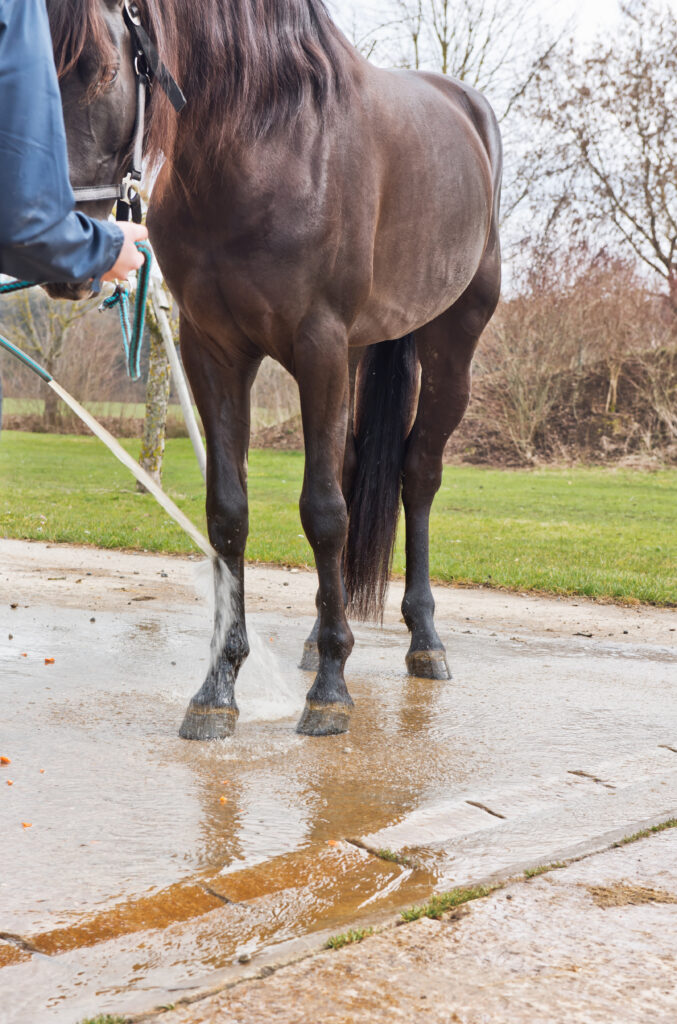Question: I’ve read a lot lately about how ice therapy may not be as beneficial for sports injuries as we’ve thought. Some studies suggest it may even delay healing. Is there similar equine research? I regularly cold hose my horse’s legs after a workout to help him recover. Should I stop doing that? What about treating using ice to treat an injury, like a pulled tendon?
Answer: This is a great question. Cold therapy, also known as cryotherapy, is a controversial subject in the human sports medicine literature. If you are inclined, you can look up some very nice reviews on this subject. These include Kweicien et al., 2021 (“The cold truth: the role of cryotherapy in the treatment of injury and recovery from exercise”) and Long et al, 2020 (“21st Century Attacks on Cryotherapy in Sports Health Care—Clinician Beware”) You are correct that there are some sports medicine practitioners that are not recommending ice therapy for people now.
Worries about cold therapy
Those who are worried that cold therapy can delay healing are typically concerned with two issues:
• Blunting of the inflammatory reaction may prevent the positive effects of inflammation. (These are, namely, removal of damaged tissue and stimulation of healing) due to vascular constriction;
• Low temperature itself can result in tissue or nerve death. This is likely true for cryotherapy of any kind for very prolonged periods of time at very low temperatures.
What research says

As for scientific evidence to address these concerns, there are results in animals—mostly rats and mice—demonstrating certain types of cryotherapy may delay healing. A study also suggests that a small percentage of horses undergoing cryotherapy with a sleeve-style unit with ice directly in contact with the skin can develop tissue injury (mostly of the skin) (“Distal limb pathologic conditions in horses treated with sleeve-style digital cryotherapy for at least 12 hours (285 cases”, Proctor-Brown et al., 2018). However, there are no studies currently evaluating the negative or positive effects of cryotherapy on tissue healing in horses, and so the assumption that cryotherapy would result in decreased healing due to a reduction in the positive effects of inflammation is purely speculative.
We have fairly good evidence (“Influence of topically applied cold treatment on core temperature and cell viability in equine superficial digital flexor tendons,” Petrov et al., 2003) that even at low temperatures, cryotherapy in the form of a circulating cooling unit with compression splint used for 60 minutes has no effect on the viability of the cells in the superficial digital flexor tendon of the horse, even at temperatures reaching 10 degrees C (50 degrees Fahrenheit). In addition, cold hosing results in less intense cooling of the horse’s limb than other types of cryotherapy, like standing in ice water or direct icing. Therefore you are unlikely to reach these low temperature levels in horses using cold hosing alone (“Evaluation of the cooling efficacy of different equine leg cooling methods,” Marlin et al., 2019).
The benefits of cold therapy
The benefits of cryotherapy are fairly well described. They range from improvements in recovery time to decreased inflammation, necrosis and pain depending on the area treated. ( “The efficacy of cooling with phase change material for the treatment of exercise-induced muscle damage: pilot study,” Kweicien et al., 2018; and “Cryotherapy suppresses tendon inflammation in an animal model,” Zhang et al., 2014).
Therefore, I don’t think there is any harm in continuing to cold hose your horse’s limbs after a workout. In the case of an acute tendon injury, I still typically recommend judicious ice therapy in the first two days. If you use other forms of cooling, avoid applying them excessively or for prolonged periods of time. We typically recommend restricting cryotherapy to 20- to 30-minute intervals at least four hours apart in the first 24 to 48 hours of an injury, and then decreasing therapy to twice daily sessions for up to two weeks.
Lecturer, Equine Sports Medicine
and Rehabilitation
University of Pennsylvania,
New Bolton Center
A native of Graham, Washington, Kara Brown, VMD, DACVSMR, earned her veterinary degree at the University of Pennsylvania School of Veterinary Medicine in 2014. She is an Equine Sports Medicine practitioner at the University of Pennsylvania, New Bolton Center in Chester County, Pennsylvania. In addition, she is a Diplomate of the American College of Veterinary Sports Medicine and Rehabilitation.








